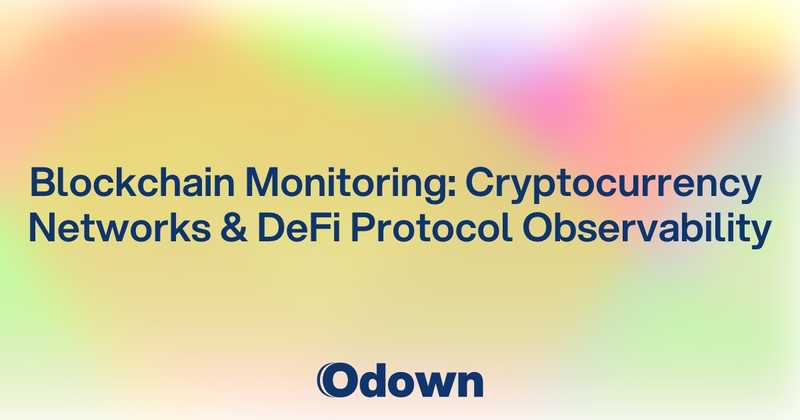Blockchain Monitoring: Cryptocurrency Networks and DeFi Protocol Observability
Your DeFi protocol just lost $50 million in a flash loan attack that took less than 13 seconds to execute. Your cryptocurrency exchange users are complaining about failed transactions, but your traditional monitoring shows everything is green. Your NFT marketplace is experiencing massive gas fee spikes during a popular mint, causing user frustration and lost sales. Welcome to blockchain monitoring, where milliseconds matter and traditional observability approaches fall short.
Blockchain environments operate fundamentally differently from traditional web applications. Transactions are immutable, state changes are consensus-driven, and performance depends on network-wide behavior rather than individual server health. When problems occur, they often cascade across the entire ecosystem faster than conventional monitoring can detect or respond.
The decentralized nature of blockchain systems creates unique observability challenges. You're not just monitoring your own infrastructure---you're monitoring your interaction with global networks where you control only a small portion of the overall system.
Advanced monitoring platforms adapt to blockchain-specific requirements by providing real-time transaction monitoring, smart contract analysis, and network health visibility. But effective blockchain monitoring requires understanding consensus mechanisms, gas economics, and the complex interdependencies that exist in decentralized systems.
Blockchain Network Monitoring: Node Health and Transaction Performance
Blockchain networks consist of distributed nodes that must work together to maintain consensus and process transactions, requiring monitoring approaches that account for network-wide behavior and individual node performance.
Node Health and Synchronization Monitoring
Blockchain nodes must stay synchronized with the network to function properly, making synchronization monitoring critical:
Block synchronization status tracks how current each node is relative to the network head. Nodes that fall behind can't process current transactions and might need intervention to resynchronize.
Peer connection monitoring ensures nodes maintain sufficient connections to other network participants. Isolated nodes can't receive new blocks or broadcast transactions effectively.
Memory pool monitoring tracks pending transactions waiting for confirmation. Large memory pools indicate network congestion that affects transaction processing times and fees.
Network Performance and Consensus Monitoring
Blockchain networks have unique performance characteristics that require specialized monitoring:
Block production time monitoring tracks how quickly new blocks are created and added to the chain. Irregular block times can indicate network stress, consensus issues, or validator problems.
Transaction throughput monitoring measures how many transactions the network processes per second. Throughput limitations affect user experience and application scalability.
Network hash rate monitoring (for proof-of-work networks) tracks the computational power securing the network. Hash rate fluctuations affect security and block production stability.
Fork Detection and Resolution Monitoring
Blockchain networks occasionally experience forks that can affect transaction finality and system behavior:
Chain reorganization detection identifies when the network chooses a different chain as the canonical version. Chain reorgs can invalidate recent transactions and affect application state.
Uncle block monitoring (for Ethereum-like networks) tracks blocks that were mined but not included in the main chain. High uncle rates indicate network congestion or timing issues.
Finality monitoring tracks when transactions become irreversible according to network consensus rules. Different networks have different finality characteristics that affect application design.
Cryptocurrency Exchange Monitoring: Trading Performance and Security
Cryptocurrency exchanges operate in high-frequency, high-stakes environments where milliseconds affect profitability and security breaches can result in massive losses.
Trading Engine Performance
Exchange trading engines must process thousands of orders per second with minimal latency:
Order book depth monitoring tracks liquidity across different trading pairs. Thin order books can cause price slippage and poor execution for large orders.
Matching engine latency measures how quickly the exchange processes and matches orders. High latency affects trading performance and can disadvantage users during volatile market conditions.
Price feed accuracy monitoring ensures that exchange prices remain consistent with broader market prices. Price discrepancies can indicate technical problems or create arbitrage opportunities.
Market Data and API Performance
Exchanges provide market data and APIs that traders and applications depend on:
WebSocket connection stability monitoring tracks real-time market data feeds. Connection drops or delays can cause trading applications to make decisions based on stale data.
REST API performance monitoring measures response times for order placement, account queries, and other API operations. Slow APIs affect user experience and automated trading systems.
Rate limit compliance monitoring ensures that API usage stays within documented limits. Rate limit violations can cause service disruptions for high-frequency trading applications.
Security and Risk Management
Exchange security monitoring focuses on detecting and preventing various types of attacks:
Suspicious trading pattern detection identifies unusual trading behavior that might indicate market manipulation or compromised accounts. Rapid large orders or coordinated activity across multiple accounts can signal problems.
Wallet security monitoring tracks hot and cold wallet balances to detect unauthorized transfers. Most exchange security breaches involve wallet compromises that can be detected through careful monitoring.
Deposit and withdrawal monitoring flags unusual patterns that might indicate money laundering or other illicit activities. Rapid deposit-withdrawal cycles or large transfers to known problematic addresses require investigation.
DeFi Protocol Monitoring: Smart Contract Performance and Risk Assessment
Decentralized Finance protocols operate autonomously through smart contracts, requiring monitoring that focuses on contract behavior, economic risks, and ecosystem interactions.
Smart Contract Execution Monitoring
DeFi protocols depend on smart contracts that must execute correctly under all market conditions:
Gas usage optimization monitoring tracks how efficiently smart contracts use computational resources. High gas usage affects user costs and can make protocols uneconomical during network congestion.
Contract state monitoring tracks critical protocol parameters like collateralization ratios, liquidity pool balances, and token reserves. State changes can affect protocol stability and user funds.
Failed transaction analysis identifies why smart contract transactions fail and whether failures indicate bugs, user errors, or economic attacks. High failure rates can indicate protocol problems.
Economic Risk and Liquidation Monitoring
DeFi protocols often involve complex economic mechanisms that require careful monitoring:
Collateralization ratio monitoring tracks loan health in lending protocols. Under-collateralized positions risk liquidation that can affect both individual users and protocol stability.
Liquidity pool monitoring tracks available liquidity for trading and withdrawals. Low liquidity can cause high slippage and affect user experience during volatile market conditions.
Arbitrage opportunity detection identifies price discrepancies that might indicate inefficient markets or protocol vulnerabilities. Persistent arbitrage opportunities can signal deeper problems.
Oracle and External Data Monitoring
DeFi protocols depend on external data sources that introduce additional monitoring requirements:
Price feed accuracy monitoring ensures that oracle data remains consistent with market prices. Price feed manipulation is a common attack vector for DeFi protocols.
Oracle response time monitoring tracks how quickly external data updates reach smart contracts. Stale data can cause incorrect protocol behavior during rapidly changing market conditions.
Data source diversity monitoring ensures that protocols don't become overly dependent on single oracle providers. Oracle centralization creates single points of failure that can affect entire protocols.
NFT Platform Monitoring: Marketplace Performance and User Experience
NFT platforms combine blockchain interactions with traditional web applications, creating unique monitoring challenges that span both domains.
Marketplace Performance and User Experience
NFT platforms must provide smooth user experiences despite blockchain complexity:
Minting performance monitoring tracks how quickly and reliably new NFTs can be created. Slow minting affects user experience and can cause failed transactions during high-demand drops.
Metadata availability monitoring ensures that NFT metadata and images remain accessible. Broken metadata links create poor user experiences and can affect NFT value.
Search and discovery performance monitoring tracks how quickly users can find and browse NFTs. Poor search performance affects marketplace usability and sales conversion.
Gas Fee Optimization and User Cost Management
NFT transactions often involve high gas fees that affect user adoption:
Gas fee prediction monitoring helps users understand transaction costs before committing to purchases. Accurate fee prediction improves user experience and reduces failed transactions.
Batch transaction optimization monitoring tracks opportunities to reduce user costs through transaction batching or layer 2 solutions. Cost optimization can significantly improve user adoption.
Failed transaction analysis identifies whether transaction failures are due to gas estimation errors, network congestion, or other factors. High failure rates indicate optimization opportunities.
Creator and Royalty Monitoring
NFT platforms must track complex ownership and royalty relationships:
Royalty payment monitoring ensures that creators receive appropriate payments when their NFTs are resold. Royalty system failures can damage creator relationships and platform reputation.
Copyright and authenticity monitoring detects unauthorized copies or stolen artwork. Content monitoring helps maintain platform quality and legal compliance.
Creator earnings analytics track how much creators earn through primary sales and royalties. Creator success metrics help platforms optimize their economic models.
Blockchain monitoring requires understanding both traditional application performance and blockchain-specific metrics. Edge computing monitoring strategies provide relevant insights for monitoring distributed systems that operate with connectivity constraints.
Ready to implement comprehensive blockchain monitoring for your cryptocurrency or DeFi applications? Use Odown and gain the specialized monitoring capabilities needed to maintain performance, security, and user experience in decentralized environments.



